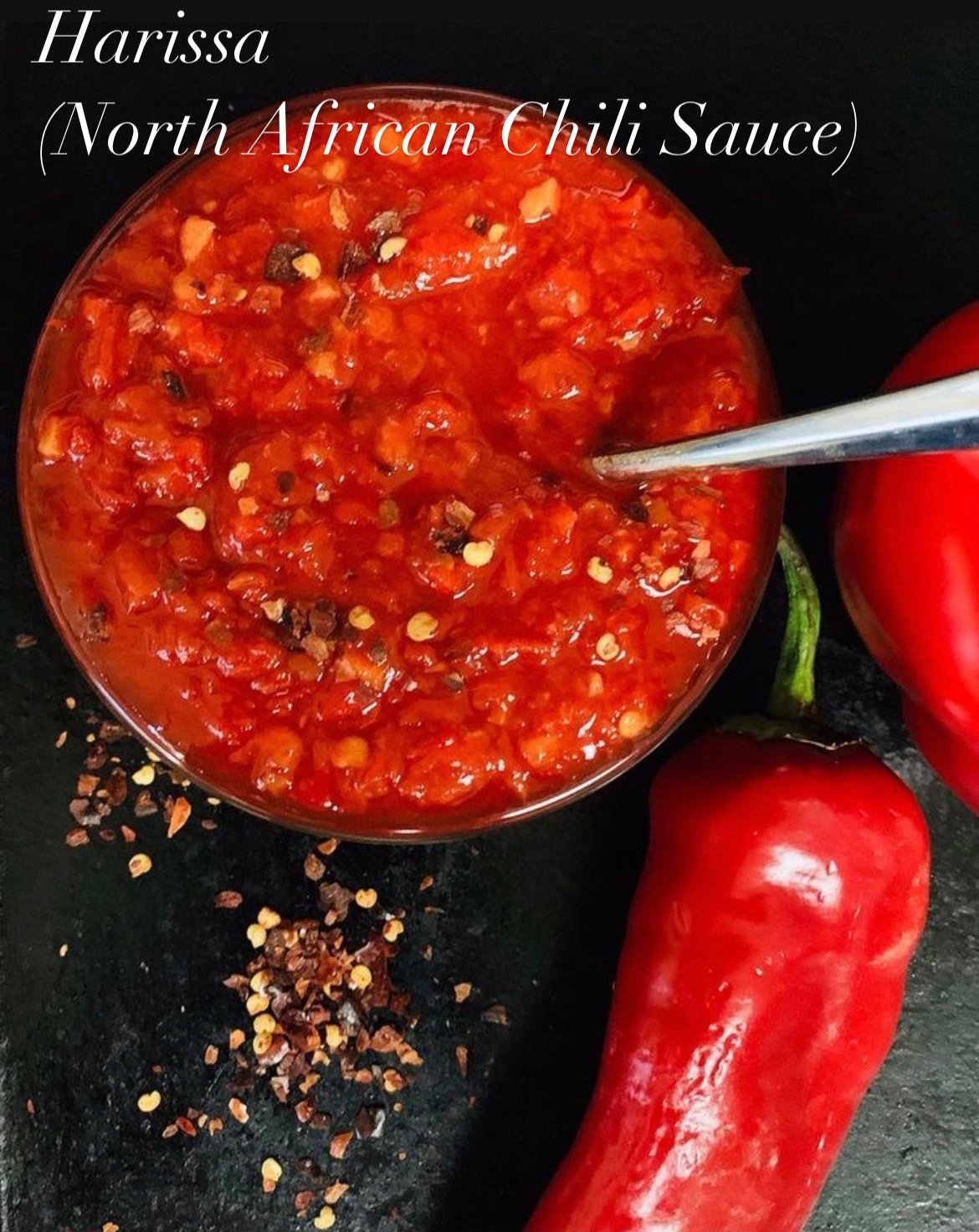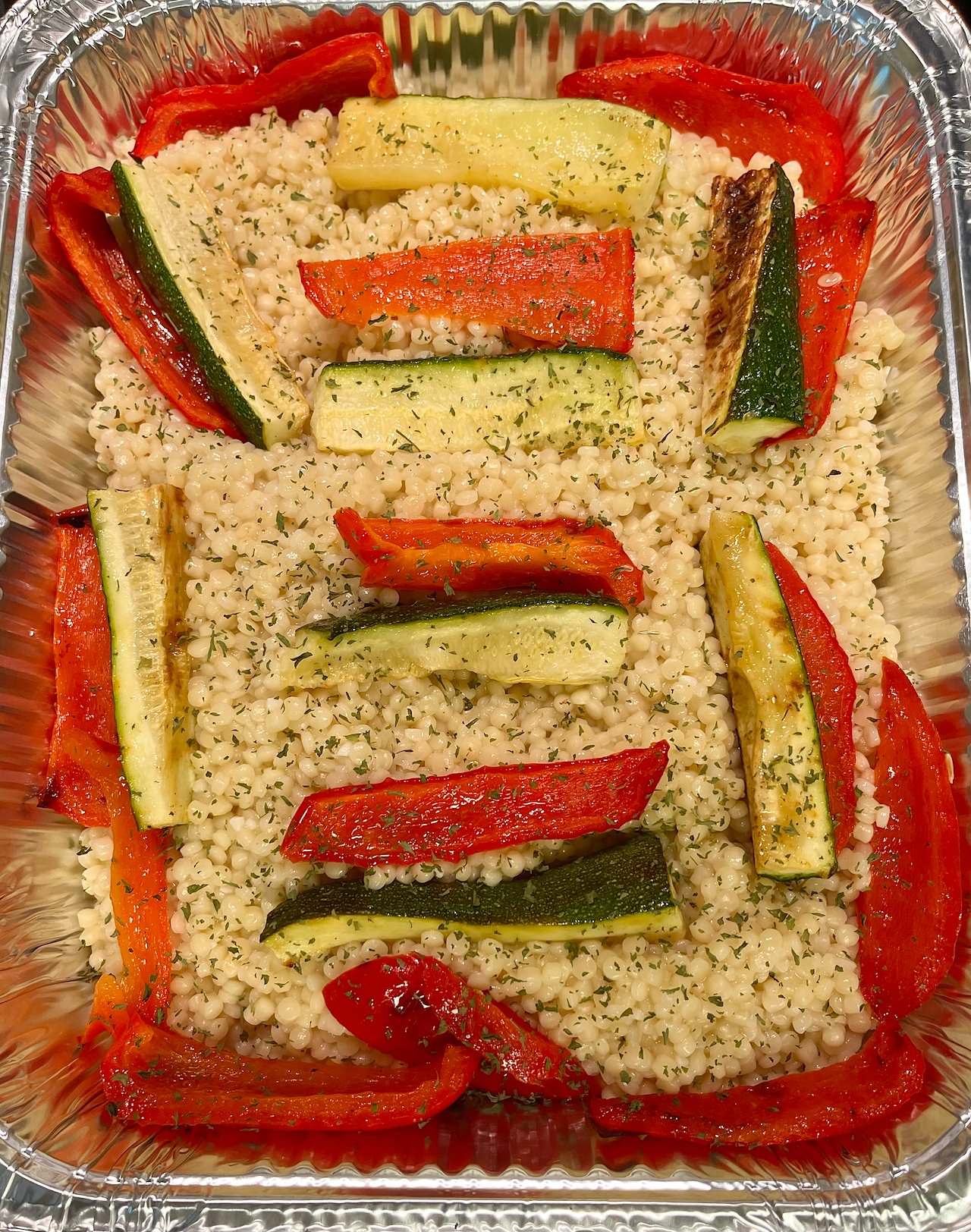
Honeyed Labneh with Chopped Apricots and Dates, Savory Walnut-Olive-Herb Crumble, Pomegranate Molasses Drizzle and Dusting of Cinnamon

Chicken Tajine / Tagine with Olives, Peppers and Tomatoes
Algerian spiced meat and potato stew (Tajine Jelbana) with roasted aromatic veggies and chakchouka with fresh cheese.
Chakchouka (شكشوكة) is also called tchoutchouka, chouchouka, choukchouka, mekbouba, tastira, ojja, shakshuka or shaqshuqa.

This unctuous North African chunky pepper sauce is everything—sweet, savory, smoky and (if you like) spicy!
An addictive spread, dipping sauce or even cooking base, savor Tara’s own recipe for this iconic North African condiment. Our harissa is entirely handmade and vegan—available in mild and spicy versions—so choose your heat and enjoy those eats!
Chicken Tajine / Tagine with Couscous and Mango Chutney (Achar el Amba) مرب المانجا

Kefta (Ground Beef or Lamb) Brochettes or Meatballs

Algerian Wedding Rice with apricots, dates or currants with toasted almonds or cashews and warm spices
Experience the mouthwatering magic of this Green Goddess—or enjoy our authentic Algerian marinade—infused into every bite of our tantalizing brochettes (aka skewers, kebabs or espetadas).

Our Green Goddess chicken is expertly crafted using our signature method.

Vegetables with Chermoula
Chermoula, also called cilantro chimichurri or pesto, is an herbaceous and aromatic paste that is commonly used in North African and Middle Eastern cuisines. It is typically made with a combination of fresh herbs, spices and other ingredients such as garlic, lemon juice, olive oil and cumin.
Chermoula is known for its vibrant green color and tangy, slightly spicy taste. It is often used as a marinade for meat, fish or vegetables or as a condiment to accompany dishes.

Homemade Fig Jam

Couscous Pan with Roasted Vegetables

Our chermoula is a sensational blend of the finest herbs, spices and citrus, meticulously crafted to deliver a burst of flavor that elevates any dish.
Handpicked organic cilantro and parsley, combined with garlic, create a vibrant and aromatic base, while the addition of lemon adds a refreshing twist. The perfect balance of spices lends a subtle heat and earthy undertone, resulting in a symphony of flavors that tantalizes the tastebuds.
Versatile in its uses, our chermoula serves as a marinade or spread for grilled meats and seafood, a sauce for roasted vegetables or a flavor enhancer in stews, soups and couscous or rice dishes.
Experience the magic of our Algerian chermoula and elevate your culinary creations to new heights.

Brik au Fromage de Feta (Baked Feta Pastry with Honey)

Chicken Meatball Tajine / Tagine

Tajine Jelbana (Meat and Potato Stew)

Maakouda with Labneh and Chermoula (Potato Pancakes with Yogurt and Chimichurri)

Merguez is a succulent North African sausage that packs a punch in every bite. With its deep red color and robust blend of spices, including cumin, paprika and harissa, this sizzling sausage offers a perfect balance of heat and savoriness.
The rich combination of lamb and beef gives it a tender texture, while the infusion of aromatic herbs like parsley and garlic adds a refreshing twist. Whether grilled, pan-fried or used to enhance tajines/tagines and couscous, merguez is a culinary star that brings a taste of the Maghreb region to your plate.

Two-Serving Roasted Veggie Couscous

Sauce Algérienne is a sweet and spicy sauce that is often available at fast-food businesses serving French tacos or kebabs as well as friteries and other similar fast-food businesses in Algeria, Tunisia, Morocco, Belgium, France and Switzerland.
Algérienne sauce has traditionally been prepared with oil and egg yolk, to which are added mustard, shallot, black pepper, vinegar and chili pepper or harissa, and sometimes also tomato or tomato sauce, anchovies and capers.

Grilled Steak with Chermoula Gremolata and Sweet Potato and Tomato Salad

A Frites Omelette in North Africa, aka Chipsi Mayai or Zege in Tanzania and elsewhere on the continent, is essentially a French fry omelette seasoned well with coriander and fresh parsley and made with or without various diced or sliced veggies.

Baklava

Kefta

Merguez Meatball Stew

The southwest region of Algeria of our family’s origin, per Ancestry.com


A Tajine, also known as a Tagine, is a traditional North African clay pot used for cooking, and it holds significant cultural and culinary importance in Algeria. This iconic cooking vessel has been an integral part of Algerian cuisine for centuries, showcasing the rich flavors and techniques of the region. The Tajine is typically made of heavy clay or ceramic material and consists of two parts: a wide, shallow base and a cone-shaped lid with a small hole at the top.
The design of the Tajine is not only functional but also enhances the flavors of Algerian dishes. The cone-shaped lid helps to circulate and trap steam, allowing the food to cook slowly and evenly. This gentle cooking method preserves the delicate flavors and textures of the ingredients, resulting in tender and aromatic dishes. Additionally, the clay material of the pot provides excellent heat retention, allowing the food to stay warm for a longer time, which is especially beneficial for communal dining and gatherings.
The history of the Tajine in Algeria can be traced back to ancient times, where it was introduced by the indigenous Berber communities.
This traditional cooking vessel has been passed down through generations, reflecting the deep-rooted culinary traditions of Algeria. The Tajine not only serves as a practical tool for cooking but also holds cultural significance. It is often used to prepare and serve traditional Algerian dishes such as couscous, lamb or chicken stews and vegetable medleys.
The Tajine's popularity has transcended borders, gaining recognition and appreciation from food enthusiasts worldwide who seek to experience the unique flavors and cooking techniques of Algerian cuisine.

Perlée Couscous aux Légumes Grillés

The fennec fox, known for its distinctive large ears and captivating charm, holds a fascinating history deeply intertwined with the majestic landscapes of Algeria. Indigenous to the Sahara Desert, the fennec fox has adapted remarkably to the harsh conditions of its environment. Its exquisite ability to survive in extreme heat and scarcity of water makes it a symbol of resilience and adaptability. These elusive creatures have captivated the imagination of locals and visitors alike, becoming an integral part of Algerian folklore and cultural heritage.
Algeria, a country of diverse landscapes and rich biodiversity, serves as a haven for the fennec fox. The unique relationship between the fennec fox and Algeria can be traced back through centuries. Nomadic tribes that have roamed the Sahara Desert for generations hold deep respect for this remarkable creature, often attributing it with mystical qualities. The fennec fox's ability to navigate the desolate desert with ease has made it a symbol of guidance and wisdom. Its presence in Algerian folklore and art reflects the deep connection between the people and the land they inhabit.